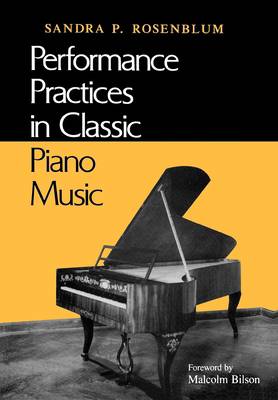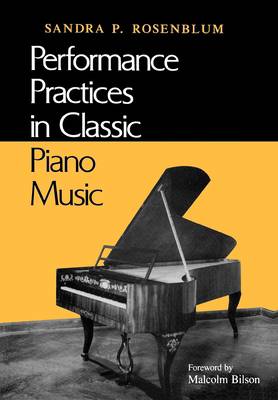
- Retrait gratuit dans votre magasin Club
- 7.000.000 titres dans notre catalogue
- Payer en toute sécurité
- Toujours un magasin près de chez vous
- Retrait gratuit dans votre magasin Club
- 7.000.0000 titres dans notre catalogue
- Payer en toute sécurité
- Toujours un magasin près de chez vous
Performance Practices in Classic Piano Music
Their Principles and Applications
Sandra P Rsoenblum, Otto Betz, Sandra P RosenblumDescription
Performance today on either the pianoforte or the fortepiano can be at once joyful, musicianly, expressive, and historically informed. From this point of view, Sandra P. Rosenblum examines the principles of performing the music of Haydn, Mozart, Beethoven, and their contemporaries as revealed in a variety of historical sources: their autographs and letters, early editions of their music, original instruments, and contemporary tutors and journals. She applies these findings to such elements of performance as dynamics, accentuation, pedaling, articulation and touch, technique and fingering, ornaments and embellishments, choice of tempo, and tempo flexibility.
Familiarity with the Classic conventions provides a framework for interpretation and an understanding of the choices available within the style, the amount of freedom a performer has, and which areas are ambiguous. Rosenblum's detailed study, copiously illustrated with musical examples, is invaluable for professional and amateur performers, serious piano students and their teachers and students of performance practices by Scarlatti and Clementi.
" . . . is and will remain unsurpassed as the study dealing with performance practice as it pertains to keyboard music of the Classical period." --American Music Teacher
"Rosenblum's monumental achievement is thorough, objective, balanced, and imaginative, a compelling blend of love and respect for the solo, chamber, and concerto literature she addresses." --Journal of Musicological Research
"The extent and quality of her research, the depth of her perception, and her musicianship together break new ground in the study of historic performance practice." --Early Keyboard Journal
"Her attention to details is absolutely scrupulous; no stone unturned, no argument unquestioned or unstated." --The Musical Times
"Its importance to thoughtful musicians cannot be overstated." --Choice
" . . . thoroughly musicological." --Performance Practice Review
" . . . indispensable . . . " --New York Times
Spécifications
Parties prenantes
- Auteur(s) :
- Editeur:
Contenu
- Nombre de pages :
- 544
- Langue:
- Anglais
- Collection :
Caractéristiques
- EAN:
- 9780253206800
- Date de parution :
- 05-09-00
- Format:
- Livre broché
- Format numérique:
- Trade paperback (VS)
- Dimensions :
- 165 mm x 253 mm
- Poids :
- 875 g

Les avis
Nous publions uniquement les avis qui respectent les conditions requises. Consultez nos conditions pour les avis.






